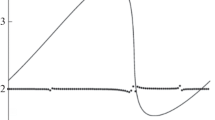Abstract
Bicompact schemes are generalized for the first time to the linear multidimensional convection–diffusion equation. Schemes are constructed using the method of lines, the finite-volume method, and bi- and tricubic Hermite interpolation of the sought function in a cell. Time stepping is based on diagonally implicit Runge–Kutta methods. The proposed bicompact schemes are unconditionally stable, conservative, and fourth-order accurate in space for sufficiently smooth solutions. The constructed schemes are implemented by applying an efficient iterative method based on approximate factorization of their multidimensional equations. Every iteration of the method is reduced to a set of independent one-dimensional scalar two-point Gaussian eliminations. Several stationary and nonstationary exact solutions are used to demonstrate the high-order convergence of the developed schemes and the fast convergence of their iterative implementation. Advantages of bicompact schemes as compared with Galerkin-type finite-element schemes are discussed.




Similar content being viewed by others
REFERENCES
M. N. Mikhailovskaya and B. V. Rogov, “Monotone compact running schemes for systems of hyperbolic equations,” Comput. Math. Math. Phys. 52 (4), 578–600 (2012).
M. D. Bragin and B. V. Rogov, “Minimal dissipation hybrid bicompact schemes for hyperbolic equations,” Comput. Math. Math. Phys. 56 (6), 947–961 (2016).
A. V. Chikitkin and B. V. Rogov, “Family of central bicompact schemes with spectral resolution property for hyperbolic equations,” Appl. Numer. Math. 142, 151–170 (2019).
B. V. Rogov, “Dispersive and dissipative properties of the fully discrete bicompact schemes of the fourth order of spatial approximation for hyperbolic equations,” Appl. Numer. Math. 139, 136–155 (2019).
M. D. Bragin and B. V. Rogov, Preprint No. 8, IPM RAN (Keldysh Inst. of Applied Mathematics, Russian Academy of Sciences, Moscow, 2019).
M. D. Bragin and B. V. Rogov, Preprint No. 11, IPM RAN (Keldysh Inst. of Applied Mathematics, Russian Academy of Sciences, Moscow, 2019).
M. D. Bragin and B. V. Rogov, “High-order bicompact schemes for shock-capturing computations of detonation waves,” Comput. Math. Math. Phys. 59 (8), 1314–1323 (2019).
M. D. Bragin and B. V. Rogov, “High-order bicompact schemes for numerical modelling of multispecies multi-reaction gas flows,” Mat. Model. 32 (6), 21–36 (2020).
B. V. Rogov and M. N. Mikhailovskaya, “On the convergence of compact difference schemes,” Math. Model. Comput. Simul. 1 (1), 91–104 (2009).
A. I. Tolstykh, High Accuracy Compact and Multioperator Approximations for Partial Differential Equations (Nauka, Moscow, 2015) [in Russian].
B. Cockburn and C.-W. Shu, “The local discontinuous Galerkin method for time-dependent convection-diffusion systems,” SIAM J. Numer. Anal. 35 (6), 2440–2463 (2014).
Y. Xu and C.-W. Shu, “Local discontinuous Galerkin methods for high-order time-dependent partial differential equations,” Commun. Comput. Phys. 7, 1–46 (2010).
H. J. Wang, C.-W. Shu, and Q. Zhang, “Stability and error estimates of the local discontinuous Galerkin method with implicit-explicit time-marching for advection-diffusion problems,” SIAM J. Numer. Anal. 53, 206–227 (2015).
H. Wang, Q. Zhang, S. Wang, and C.-W. Shu, “Local discontinuous Galerkin methods with explicit-implicit-null time discretizations for solving nonlinear diffusion problems,” Sci. China Math. 63, 183–204 (2020).
E. F. Toro and G. I. Montecinos, “Advection-diffusion-reaction equations: Hyperbolization and high-order ADER discretizations,” SIAM J. Sci. Comput. A 36 (5), 2423–2457 (2014).
H. Nishikawa, “On hyperbolic method for diffusion with discontinuous coefficients,” J. Comput. Phys. 367, 102–108 (2018).
J. Lou, L. Li, H. Luo, and H. Nishikawa, “Reconstructed discontinuous Galerkin methods for linear advection-diffusion equations based on first-order hyperbolic system,” J. Comput. Phys. 369, 103–124 (2018).
M. D. Bragin and B. V. Rogov, “Conservative limiting method for high-order bicompact schemes as applied to systems of hyperbolic equations,” Appl. Numer. Math. 151, 229–245 (2020).
B. M. Naimark, A. T. Ismail-zade, A. I. Korotkii, A. P. Suetov, and I. A. Tsepelev, “Numerical implementation of a hydrodynamic 3D-model of the formation of sedimentary basins,” Trudy Inst. Mat. Mekh. Ural. Otd. Ross. Akad. Nauk 5, 143–173 (1998).
E. Hairer and G. Wanner, Solving Ordinary Differential Equations II: Stiff and Differential-Algebraic Problems (Springer-Verlag, Berlin, 1996).
R. Alexander, “Diagonally implicit Runge–Kutta methods for stiff O.D.E.’s,” SIAM J. Numer. Anal. 14 (6), 1006–1021 (1977).
A. A. Samarskii and E. S. Nikolaev, Numerical Methods for Grid Equations (Nauka, Moscow, 1978; Birkhäuser, Basel, 1989).
N. N. Yanenko, The Method of Fractional Steps: The Solution of Problems of Mathematical Physics in Several Variables (Nauka, Novosibirsk, 1967; Springer-Verlag, Berlin, 1971).
P. J. Van der Houwen and B. P. Sommeijer, “Approximate factorization for time-dependent partial differential equations,” J. Comput. Appl. Math. 128 (1–2), 447–466 (2001).
B. V. Rogov and A. V. Chikitkin, “About the convergence and accuracy of the method of iterative approximate factorization of operators of multidimensional high-accuracy bicompact schemes,” Mat. Model. 31 (12), 119–144 (2019).
M. D. Bragin and B. V. Rogov, “Iterative approximate factorization of difference operators of high-order accurate bicompact schemes for multidimensional nonhomogeneous quasilinear hyperbolic systems,” Comput. Math. Math. Phys. 58 (3), 295–306 (2018).
Funding
This work was supported by Moscow Center for Fundamental and Applied Mathematics, Аgreement with the Ministry of Science and Higher Education of the Russian Federation, no. 075-15-2019-1623.
Author information
Authors and Affiliations
Corresponding authors
Additional information
Translated by I. Ruzanova
Rights and permissions
About this article
Cite this article
Bragin, M.D., Rogov, B.V. Bicompact Schemes for the Multidimensional Convection–Diffusion Equation. Comput. Math. and Math. Phys. 61, 607–624 (2021). https://doi.org/10.1134/S0965542521040023
Received:
Revised:
Accepted:
Published:
Issue Date:
DOI: https://doi.org/10.1134/S0965542521040023



